Introduction
Have you ever heard of a whole town turning into a massive stage for a festival? That’s exactly what happens during Dhanu Jatra, a one-of-a-kind celebration held every year in Bargarh, Odisha. Well, here’s your chance! Dhanu Jatra 2025, the world’s largest open-air theater festival, is happening from January 3 to January 13 in Bargarh, Odisha. This isn’t your regular festival—it’s recognized as the world’s largest open-air theater! For ten days straight, the streets of Bargarh transform into the mythical city of Mathura, and nearby Ambapali village becomes Gopapura, where little Krishna’s playful adventures come to life. Even the Jeera River plays its part, becoming the sacred Yamuna.
What makes Dhanu Jatra so special? It’s the way the whole community comes together to bring mythology to life. Imagine King Kansa walking through the streets, commanding attention, and even interacting with people—yes, he talks to visitors, locals, and sometimes even government officials! The energy is contagious, with music, drama, and colorful performances happening everywhere—from busy markets to quiet alleys.
If you love stories, enjoy vibrant cultural experiences, or just want to witness something truly unforgettable, Dhanu Jatra is a must-visit. It’s not just a festival; it’s an experience that makes history and mythology feel alive and fun.
What is Dhanu Jatra?
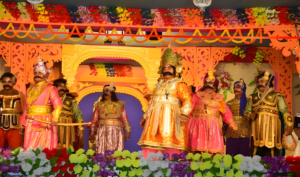
Dhanu Jatra is much more than just a festival; it’s a grand theatrical performance that engulfs an entire town. Held in Bargarh, Odisha, it brings to life the legendary tale of Lord Krishna’s early years and King Kansa’s tyranny. For ten days, every nook and corner of Bargarh becomes a stage where drama unfolds, blending culture, mythology, and art seamlessly. What’s truly fascinating is how the town itself is transformed—markets become bustling courtyards of Mathura, streets turn into royal pathways, and locals take up roles as mythical characters.
This unique festival dates back to 1947-48, coinciding with India’s independence. It was conceived as a symbolic celebration of good triumphing over evil—a message that resonates deeply with its audience. Over the years, it has grown in scale, drawing performers and spectators from all over the country. The festival’s grandeur is amplified by the enthusiastic participation of the local community, who ensure every detail aligns with the mythological story being depicted.
At the heart of Dhanu Jatra is the larger-than-life character of King Kansa. His interactions with visitors and even government officials are a spectacle in themselves, adding a humorous and engaging touch to the festival. Meanwhile, the charming antics of little Krishna and his adventures in Ambapali (Gopapura) captivate audiences of all ages, making it a perfect blend of drama and entertainment.
1. The History and Significance of Dhanu Jatra
Dhanu Jatra isn’t just a modern-day celebration; it has deep roots and a rich history that add to its charm. Let’s delve into where it all began and why it holds such cultural importance today.
Origins of Dhanu Jatra
The festival traces its origins back to 1947-48, coinciding with India’s independence. This timing wasn’t a coincidence. Dhanu Jatra was conceived as a way to symbolize the triumph of good over evil, reflecting the nation’s newfound freedom from colonial rule. It was a creative, theatrical expression of hope and unity for a country stepping into a new era.
The people of Bargarh chose the tale of Lord Krishna and King Kansa from Hindu mythology as the central theme. This story, rich in symbolism and dramatic appeal, resonated with the ideals of justice, courage, and righteousness that India sought to uphold.
Cultural and Religious Importance
For many, Dhanu Jatra is more than entertainment—it’s a cultural and spiritual journey. The festival highlights the eternal battle between dharma (righteousness) and adharma (evil), with Lord Krishna representing divine wisdom and King Kansa embodying tyranny and ego.
The reenactment of this story reminds us of the values that underpin Indian culture: humility, justice, and the ultimate victory of good. Each performance, dialogue, and interaction during Dhanu Jatra is steeped in these principles, making it a deeply meaningful event for both participants and spectators.
2. The Mythological Connection: A Journey into the Mahabharata and Puranas
Dhanu Jatra is all about bringing ancient myths to life, especially stories from the Mahabharata and Puranas. At the heart of it, you’ll find a battle between good and evil, with Lord Krishna standing up to the evil King Kansa. It’s a story you’ve probably heard before, but seeing it play out live, right in front of you, is something else!
What’s the Story Behind It?
So, here’s the deal: Kansa is the evil king who’s terrified of a prophecy. It says that Devaki’s son will eventually bring an end to his rule. To stop this, Kansa tries everything to harm her children. But guess what? He can’t stop the birth of Krishna, and that’s where the magic happens.
As the festival unfolds, we see Krishna’s cleverness, his bravery, and how he starts taking down Kansa’s evil plans—even as a little kid. One of the most exciting moments is when Krishna escapes from Kansa’s palace. Imagine the little hero sneaking out while Kansa’s soldiers search everywhere for him!
The Big Battle
The fun doesn’t stop there. As Dhanu Jatra goes on, you’ll see Krishna outsmarting Kansa’s soldiers and taking on his challenges. And of course, the grand finale—Kansa’s defeat. The whole town is part of this epic showdown, and you’ll feel the thrill as Krishna wins and evil is defeated once and for all.
3. Key Highlights of Dhanu Jatra
Dhanu Jatra is more than just a festival; it’s an experience. The whole town of Bargarh turns into a living stage for a week. If you’re planning to visit, here are some of the key highlights that make this festival truly magical!
Bargarh as Mathura: The Town That Becomes a Stage
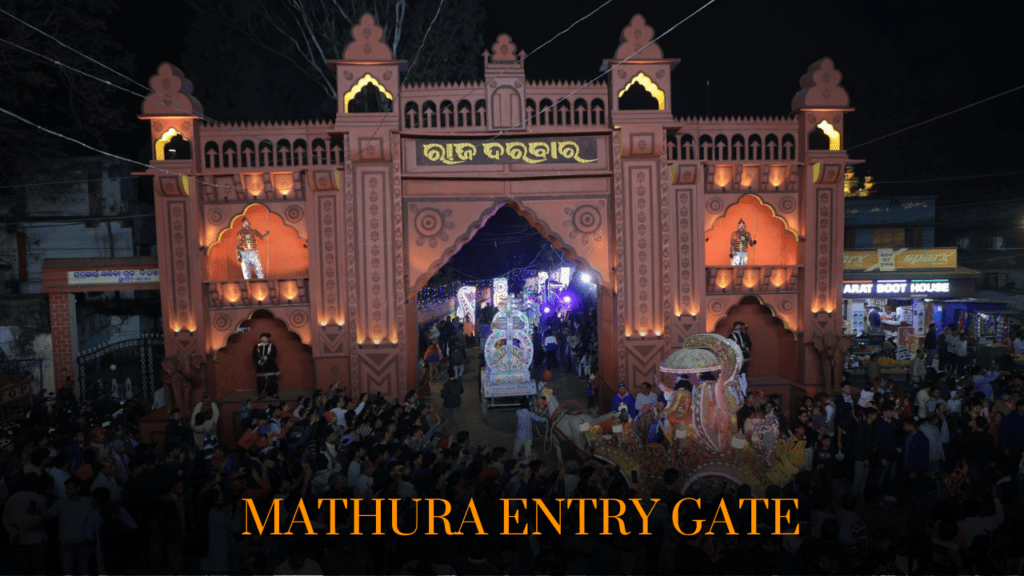
When you step into Bargarh, it feels like you’ve walked straight into the mythical city of Mathura. The streets, the market areas, and even the houses become part of the stage, where Krishna’s story unfolds. It’s not like any other performance; you’re part of the show! The actors don’t just perform on a stage—they interact with the crowd, making everyone feel like they’re part of the ancient story. The whole town becomes a vibrant backdrop for the legendary tale of good versus evil. Bargarh is Mathura, and you’re right there in the middle of it.
Ambapali as Gopapura: Where Krishna’s Childhood Comes to Life
Just a short distance away, the village of Ambapali is transformed into Gopapura, a place filled with the playful moments of Lord Krishna’s childhood. Here, you’ll see Krishna spending time with his friends, playing pranks, and enjoying the simple joys of life. Watching these scenes gives you a sense of what it might have been like during Krishna’s youth. It’s wholesome, fun, and filled with laughter. You can almost feel like you’re back in ancient times, seeing Krishna’s playful side.
Key Characters and Their Portrayals in the 2025 Dhanu Yatra:
- King Kansa: The central antagonist, King Kansa, is traditionally portrayed by a prominent local artist. In the 2025 edition, Bhubaneswar Pradhan has been selected to play this role, succeeding Hrusikesh Bhoi, who had portrayed Kansa for several years.
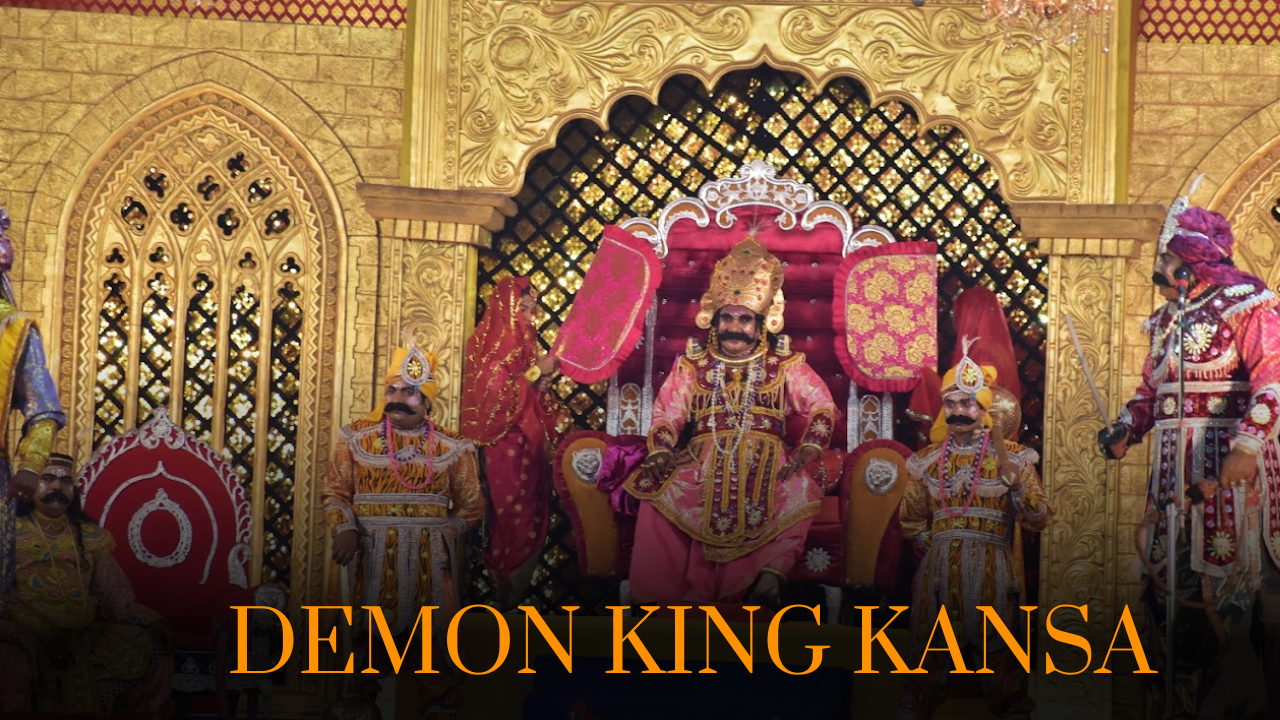
Demon king Kansa Bargarh Dhanu Jatra 2025 - Lord Krishna and Balaram:
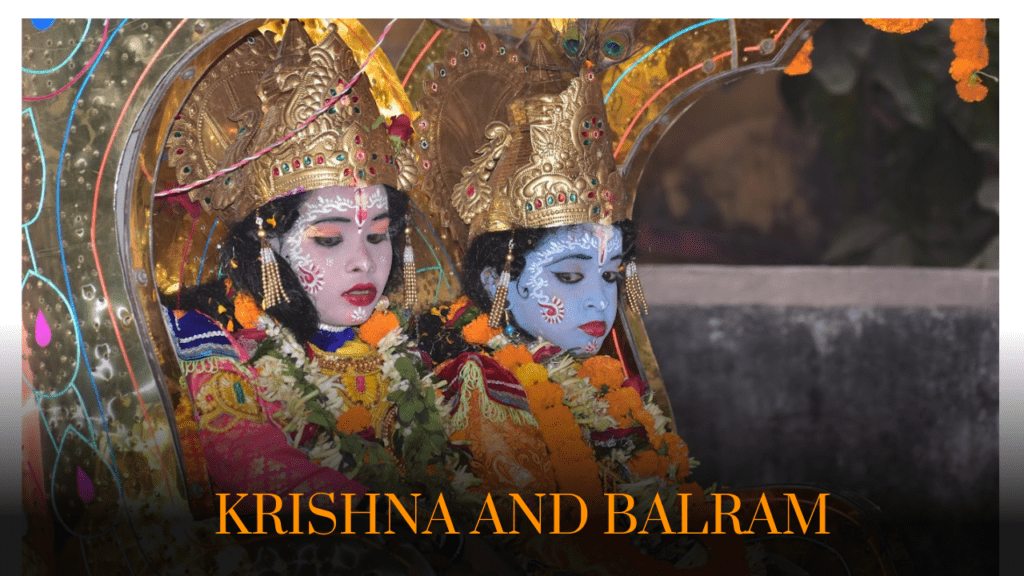
Bargarh Dhanu jatra 2025 – Krishna and Balaram The protagonist, Lord Krishna and Balaram, is depicted by another local artist, continuing the tradition of embodying this divine character.
Other Characters:
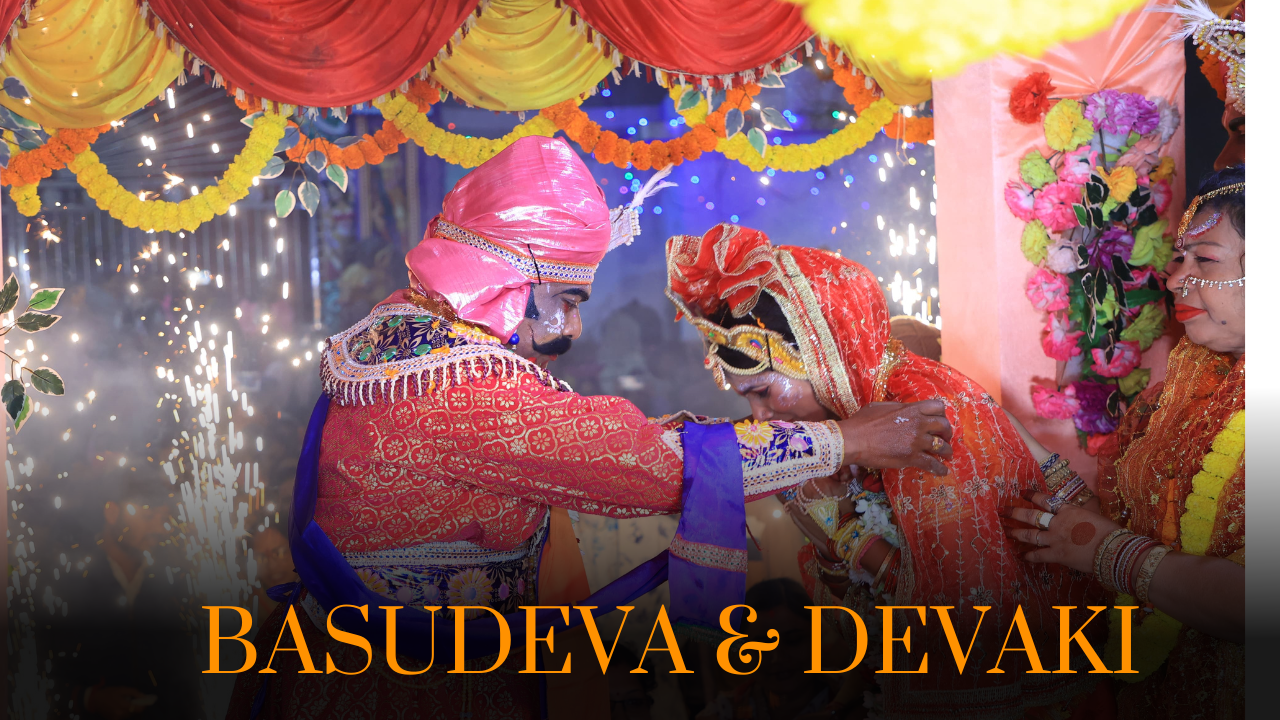
Bargarh Dhanu jatra 2025 -Basudev and devaki 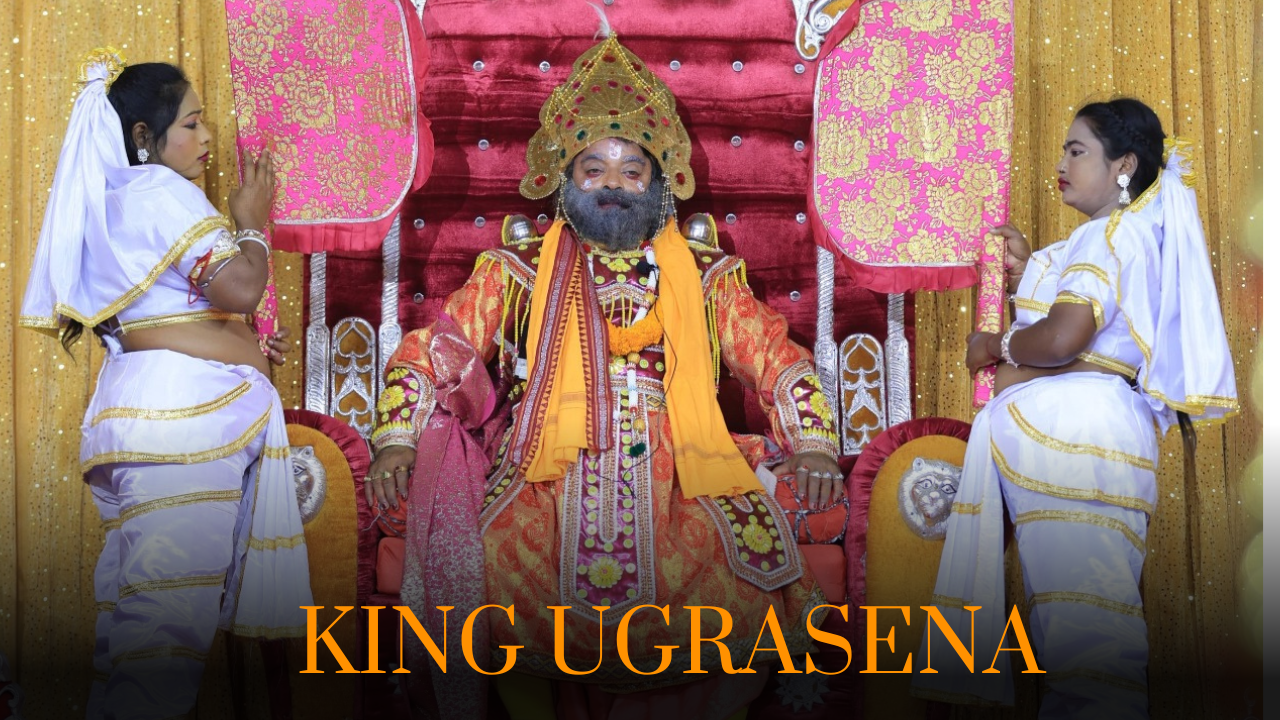
Bargarh Dhanu jatra 2025 – king ugrasena The festival features a variety of characters from the Krishna Leela, including Lord Balaram, Vasudeva, Devaki, Nanda, Yashoda, and various gopis and gopas. These roles are typically filled by local artists selected through auditions conducted by the Dhanu Yatra Committee.
The Role of King Kansa: A Villain You Can’t Miss

Now, let’s talk about the man of the hour—King Kansa. He’s the villain in this epic tale, but during Dhanu Jatra, he’s so much more than just an actor. Kansa’s character is one of the most exciting parts of the festival. He doesn’t just play his role; he interacts with the audience, calling out officials, tourists, and even visitors to his court. Imagine sitting there, watching the drama unfold, and suddenly Kansa points at you, asking you to be part of his world! It’s a fun and immersive experience that makes the entire event feel like a live, interactive play. He’s a villain, but with the crowd’s energy, Kansa becomes a larger-than-life character.
The Processions and Performances: A Feast for the Senses
One of the best things about Dhanu Jatra is the vibrant processions and performances. The streets are filled with traditional music, dance, and colorful costumes. You’ll see Odissi dancers, drummers, and actors performing their roles with passion. These performances are not just about showing the story—they’re about celebrating the culture. The dances, the songs, the costumes—they all bring the festival to life. Every day, there’s a new performance, so no two days are the same. It’s a visual feast and a celebration of Odisha’s rich cultural heritage.
4. Behind the Scenes: Preparing for Dhanu Jatra

You might think the magic of Dhanu Jatra just happens overnight, but it’s the result of months of preparation by a dedicated team of artists, craftsmen, and the entire Bargarh community. From costumes to rehearsals, the effort that goes into making this festival world-famous is nothing short of incredible!
Months of Preparation: The Work Begins Early
The planning for Dhanu Jatra starts months in advance. Local artists and craftsmen begin their work long before the festival begins. This isn’t just about putting together a play; it’s about creating a living spectacle that takes over the whole town. Every year, costumes are redesigned, sets are built, and performers rehearse for hours to make sure everything runs smoothly. This attention to detail ensures that every performance is as magical as the last. It’s a huge undertaking that requires months of hard work from everyone involved!
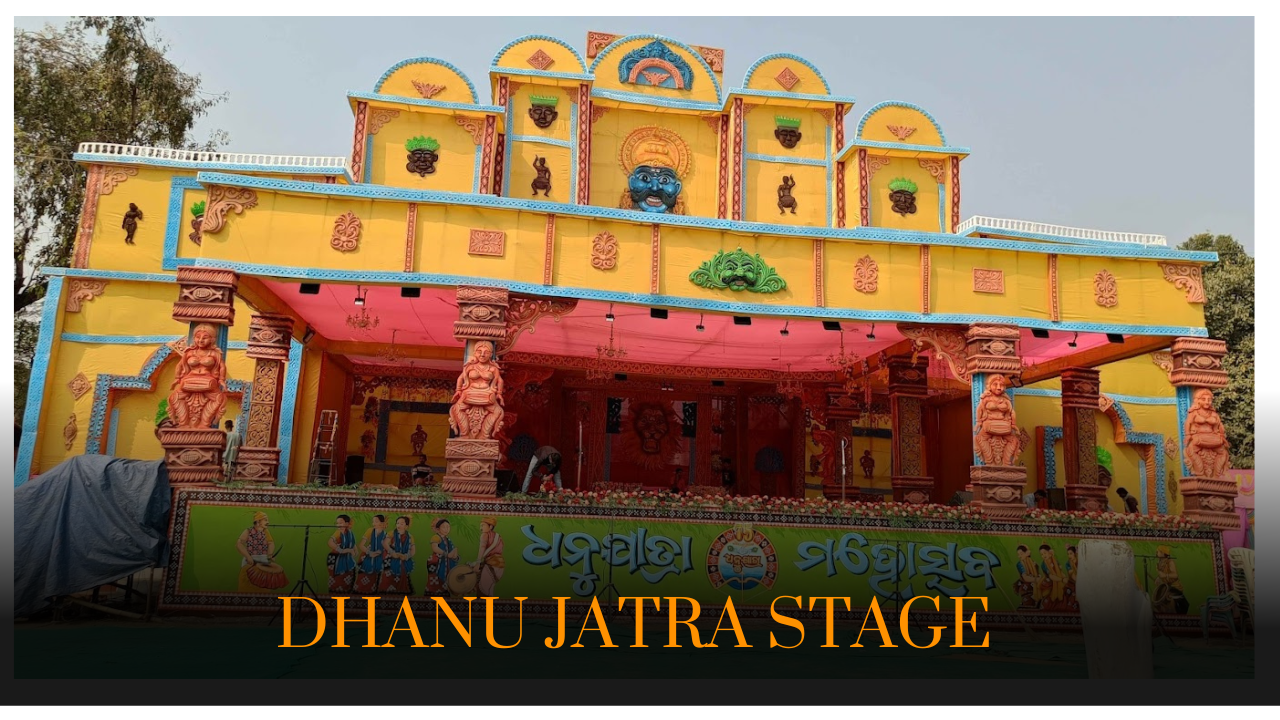
The Elaborate Costumes: How Much Do They Weigh?
One thing that catches everyone’s eye at Dhanu Jatra is the costumes. And let me tell you, they are no ordinary outfits! From the royal robes of Kansa to the simple, playful attire of Krishna, the costumes are intricate and heavy. Did you know that Kansa’s costume alone weighs over 10 kilograms? Yes, 10 kilograms! It’s not just a costume; it’s an art piece that tells the story of the character. The level of detail that goes into creating these costumes is amazing. The local tailors and designers use traditional fabrics and handcrafts, making sure each costume is authentic and vibrant.
Rehearsals: Perfecting Every Scene
Once the costumes are ready, the real work begins—rehearsals. Local actors, who are both amateurs and seasoned performers, practice their lines, movements, and expressions for weeks. It’s not just about memorizing the script; it’s about bringing the mythological characters to life. Every movement has to be perfect, every expression has to convey the depth of the story. Imagine actors practicing dances, dialogues, and even interacting with the audience! They get so involved in their roles that sometimes it’s hard to tell where the actor ends and the character begins.
The Role of Local Craftsmen: Creating the Sets
Creating the sets for Dhanu Jatra is another huge task. The streets of Bargarh become the stage, and the set builders ensure that every corner looks like Mathura or Gopapura. It’s not just about building props; it’s about turning the whole town into a living, breathing part of the play. The local craftsmen and artists work tirelessly to create props and backdrops that transport the audience to ancient times. The entire process requires creativity, patience, and a lot of teamwork.
The Community’s Role: It’s a Collective Effort
One of the most heartwarming aspects of Dhanu Jatra is that it’s not just the artists and performers who contribute. The whole Bargarh community comes together to make it happen. Local vendors set up food stalls, shops provide costumes and props, and even the residents open their homes to tourists. The entire town becomes part of the celebration, making it a community-driven event. It’s a festival that isn’t just for tourists—it’s for everyone.
Highlighted Points:
- Months of Preparation: Dhanu Jatra requires months of hard work from everyone involved—artists, craftsmen, and the community.
- Elaborate Costumes: Kansa’s costume weighs over 10 kg, showcasing the attention to detail.
- Rehearsals: Actors, dancers, and performers rehearse for weeks to perfect every scene.
- Local Craftsmen: The community crafts props and backdrops, transforming Bargarh into the world of Krishna.
- Community Effort: Dhanu Jatra is a collective effort from the entire town, where everyone plays a part.
5. Economic Growth in Dhanu Jatra
Bargarh’s Transformation During Dhanu Jatra
During the festival, Bargarh’s population swells from under 100,000 to over 500,000, as visitors flock to witness the performances.
The town’s infrastructure, including accommodations, eateries, and transportation, experiences a significant uptick in activity, reflecting the festival’s importance to the local economy.
6. The Heart of Dhanu Jatra: Drama, Meena Bazar, and Traditional Dances
At Dhanu Jatra, the magic doesn’t just come from watching the action unfold; it’s an experience that pulls you in, making you feel like you’re living in the heart of an ancient myth. From the colorful Sambalpuri dances to the lively Meena Bazar and the engaging local drama, every part of this festival is designed to make you part of the story.
Local Drama: Where Mythology Comes Alive
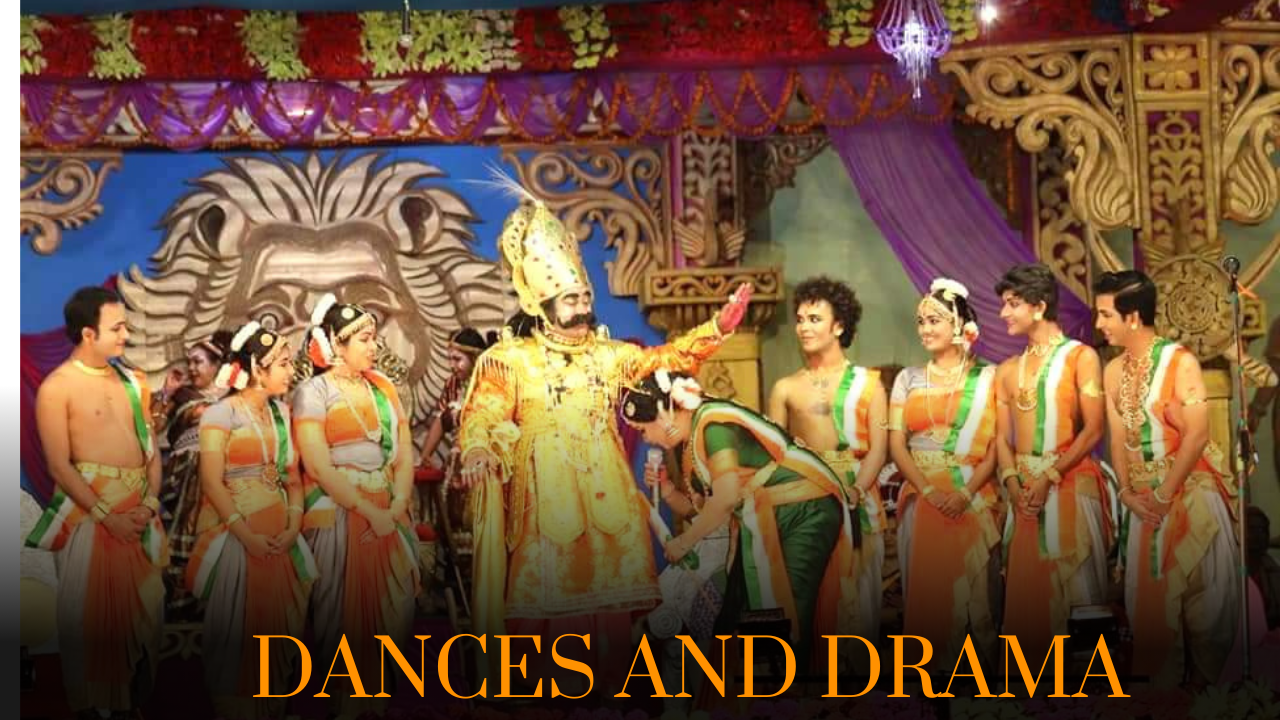
Bargarh-Dhanu-jatra-2025
One of the most remarkable aspects of Dhanu Jatra is the local drama that takes place all around you. Imagine walking down the street, and suddenly, you’re right in the middle of a Mahabharata scene! The festival transforms Bargarh into a giant stage, with over 3,000 performers bringing to life the legendary battle between Lord Krishna and King Kansa. These aren’t just performances in the traditional sense; they’re interactive experiences, where you might find yourself applauding Krishna’s clever tricks or feeling the tension of Kansa’s rule as it unfolds right in front of you.
The local drama isn’t confined to a single stage—it stretches across the town, from street corners to temple steps, making the entire town feel like a living, breathing myth. And what makes it even more special? The audience participation. You could find yourself caught up in the excitement, maybe even having a laugh with Krishna or joining in a lively moment with the Gopis. The energy is contagious, and you quickly feel like you’re part of the show!
Sambalpuri Dances: A Rhythmic Celebration
Dance is another essential ingredient that makes Dhanu Jatra come alive. The festival showcases Sambalpuri dances, which are rich in history and brimming with energy. You’ll see Chhau, Ghumra, and Sambalpuri dances performed with such enthusiasm and passion that it’s hard to resist joining in. These dances don’t just tell a story—they celebrate life, the gods, and the triumph of good over evil.
The rhythmic beats of the dhol, flute, and mandal instruments accompany the performers, making the dance more mesmerizing. Sambalpuri dance is distinctive, with bold, expressive movements and vibrant costumes that reflect the essence of Odisha’s rich cultural heritage. It’s a lively and joyful experience, especially when you see children and adults alike performing these dances with so much pride and energy.
Each dance, whether it’s celebrating Krishna’s childhood or depicting the battle between Krishna and Kansa, tells a story through movement and expression, and you can feel the spiritual connection and the deep-rooted tradition behind every step.
Meena Bazar: A Vibrant Open Shopping Mall
Now, let’s talk about the Meena Bazar, which adds a modern touch to the festival’s traditional vibe. This open-air shopping mall is the place where you can find a beautiful mix of art, culture, and shopping. Picture yourself strolling through a bustling market filled with colorful stalls, each offering handmade crafts, ethnic clothing, Sambalpuri sarees, and traditional jewelry. It’s not just about the shopping—it’s about being surrounded by the art and soul of Odisha.
The Meena Bazar offers a rich variety of local crafts and artifacts, and it’s the perfect place to find souvenirs that reflect the heritage and traditions of Western Odisha. From wooden sculptures and handwoven fabrics to paintings that tell stories of ancient gods and kings, it’s a treasure trove for anyone looking to take a piece of Odisha home.
What makes the Meena Bazar even more fascinating is the energy it brings. The marketplace is alive with colors, sounds, and the constant buzz of people interacting with the vendors. It feels like a blend of tradition and modernity, with both locals and tourists coming together in the heart of Bargarh to experience something truly special.
A Festival Like No Other
When you walk through Bargarh during Dhanu Jatra, it’s like stepping into another world. The local drama, Sambalpuri dances, and Meena Bazar combine to create an experience that’s not just a celebration but a living, breathing piece of history. The festival invites you to be a part of something bigger—where mythology, dance, and community come together in a way that feels both timeless and incredibly personal.
Whether you’re swept up in the energetic dance performances, mesmerized by the local drama, or lost in the vibrancy of the Meena Bazar, Dhanu Jatra is more than just an event—it’s a festival where tradition, culture, and human connection come together most beautifully. And by the end of it, you’ll feel like you’ve witnessed something truly magical.
Celebrity Involvement and Duration
Dhanu Jatra spans 11 days, featuring a series of performances that depict episodes from Lord Krishna’s life. While the festival primarily involves local artists, it occasionally attracts celebrities and dignitaries who participate in or attend the events, adding to the festival’s prestige.
Global Recognition
What started as a local festival has grown to gain national and international attention. The Guinness World Records recognized Dhanu Jatra as the largest open-air theater in the world. Tourists, journalists, and culture enthusiasts from across the globe flock to Bargarh to witness this unparalleled spectacle.
This recognition has also boosted awareness of Western Odisha’s rich cultural heritage, shining a spotlight on the region’s traditional art forms, local cuisines, and warm hospitality.
7. How to Experience Dhanu Jatra as a Visitor
If you’re thinking of visiting Bargarh during Dhanu Jatra, you’re in for an experience like no other! The festival is an absolute must-see, and getting the most out of it involves more than just watching the performances. Let’s take a look at how you can make the most of your visit.
Best Time to Visit: When Does Dhanu Jatra Happen?
Dhanu Jatra usually takes place in January, and it’s best to plan your trip around this time. The festival spans about 11 days, so you have a window to choose from. If you want to catch the grand opening or the dramatic final scenes, try to plan your visit around those dates. The weather in January is pleasant, which makes it a great time to explore both the festival and the town.
How to Get to Bargarh: Travel Tips
Getting to Bargarh is quite straightforward. The town is well-connected by road, rail, and air.
- By Air: The nearest airport to Bargarh is Jharsuguda Airport (JRG), located around 55 kilometers (approximately 34 miles) away. This airport is well-connected to major cities like Bhubaneswar and Kolkata, making it a convenient option for travelers heading to Bargarh during the Dhanu Jatra festival. The drive from Jharsuguda Airport to Bargarh typically takes around 1 to 1.5 hours depending on traffic conditions.
- By Train: The Bargarh Railway Station is well-connected to major cities, so you can easily get a train from places like Bhubaneswar or Raipur.
- By Road: Bargarh is accessible by buses and taxis from nearby cities like Bhubaneswar, Raipur, and Sambalpur. If you’re driving, the roads are scenic and make for a pleasant road trip.
Where to Stay: Accommodation Options
While Bargarh might not have the luxury hotels you find in bigger cities, there are plenty of guest houses, hotels, and homestays to choose from. During the festival, the demand for rooms rises, so it’s a good idea to book your stay in advance.
- For a budget-friendly option, you can find decent guesthouses close to the festival area.
- If you’re looking for something more comfortable, several mid-range hotels offer modern amenities.
What to Do Before and After the Performances: An Itinerary
Here’s how to make your visit even more special:
- Start your day with ‘Chaul Bara’: If you’re in Bargarh, you’ve got to try the local breakfast treat, Chaul Bara. This delicious breakfast snack is made of rice and is a perfect start to your festival day.
- Visit the Key Performances: The main attractions during Dhanu Jatra are the various open-air performances, but don’t forget to wander around the town to see the set designs and costumes. The streets themselves become part of the performance.
- Explore the local markets: While in Bargarh, take a stroll through the local markets where you’ll find everything from traditional crafts to festival memorabilia. It’s a great place to pick up souvenirs.
- Catch the Processions: Don’t miss the vibrant processions featuring Krishna, Kansa, and other characters. The parades are full of music, dancing, and excitement. They provide a fantastic opportunity for photos.
- Evening Performances and Events: After a day of exploration, you can enjoy the evening performances. The lighting and music at night add an extra layer of magic to the scenes.
Top Tips for Visitors:
- Book in Advance: The festival draws a large crowd, so securing your accommodation early is a must.
- Dress Comfortably: Since you’ll be walking around a lot, make sure to wear comfortable shoes and light clothing. The weather is usually pleasant, but it can get chilly in the evenings, so carry a light jacket.
- Plan for Crowds: With the influx of visitors, it can get crowded. Be prepared for large crowds, especially during peak performance times. Patience is key!
Highlighted Points:
- Best Time to Visit: Dhanu Jatra is held in January, typically for 11 days.
- Travel Options: Bargarh is accessible by air, train, and road from nearby cities like Raipur and Bhubaneswar.
- Accommodation: Guesthouses, hotels, and homestays offer various options for staying in Bargarh. Book in advance!
- Itinerary Suggestions: Start your day with Chaul Bara, enjoy the processions and performances, and explore the local markets.
- Top Tips: Book early, dress comfortably, and plan for crowds!
Also read The Rich Cultural Heritage of Sambalpur

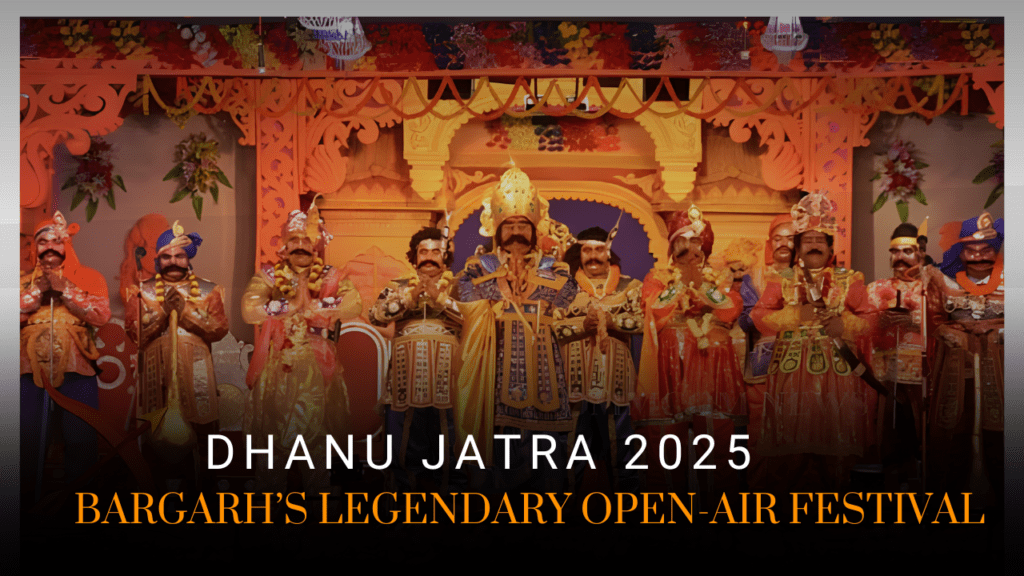

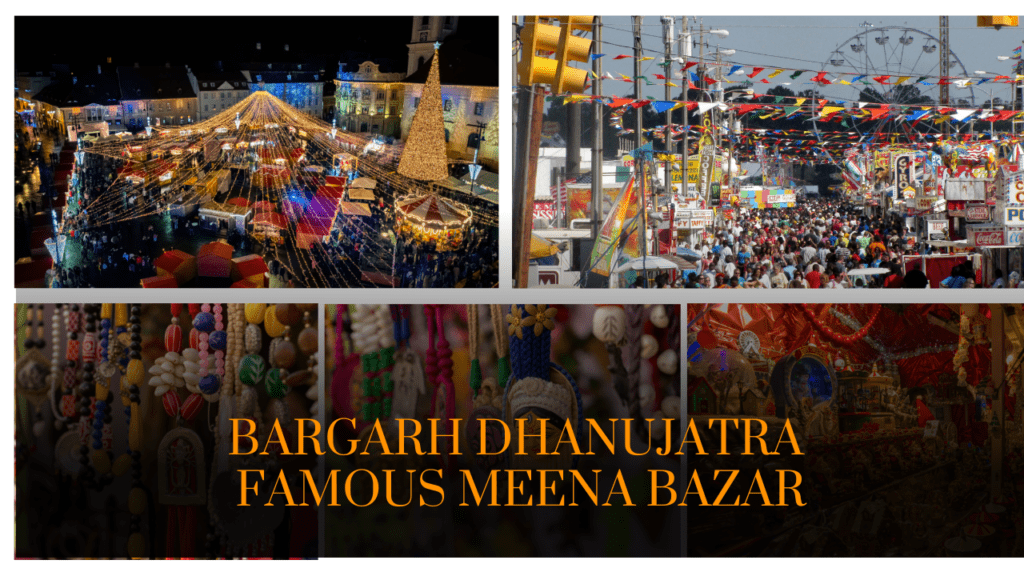 m ₹10 lakh to ₹1.5 crore. This kind of funding is a game-changer. It’s not just about supporting a cultural event; it’s about improving infrastructure, promoting tourism, and ensuring that local artists and performers are honored for their contributions. This boost helps the town thrive, creating jobs, supporting the creative community, and making Bargarh a prominent destination on the tourism map.
m ₹10 lakh to ₹1.5 crore. This kind of funding is a game-changer. It’s not just about supporting a cultural event; it’s about improving infrastructure, promoting tourism, and ensuring that local artists and performers are honored for their contributions. This boost helps the town thrive, creating jobs, supporting the creative community, and making Bargarh a prominent destination on the tourism map.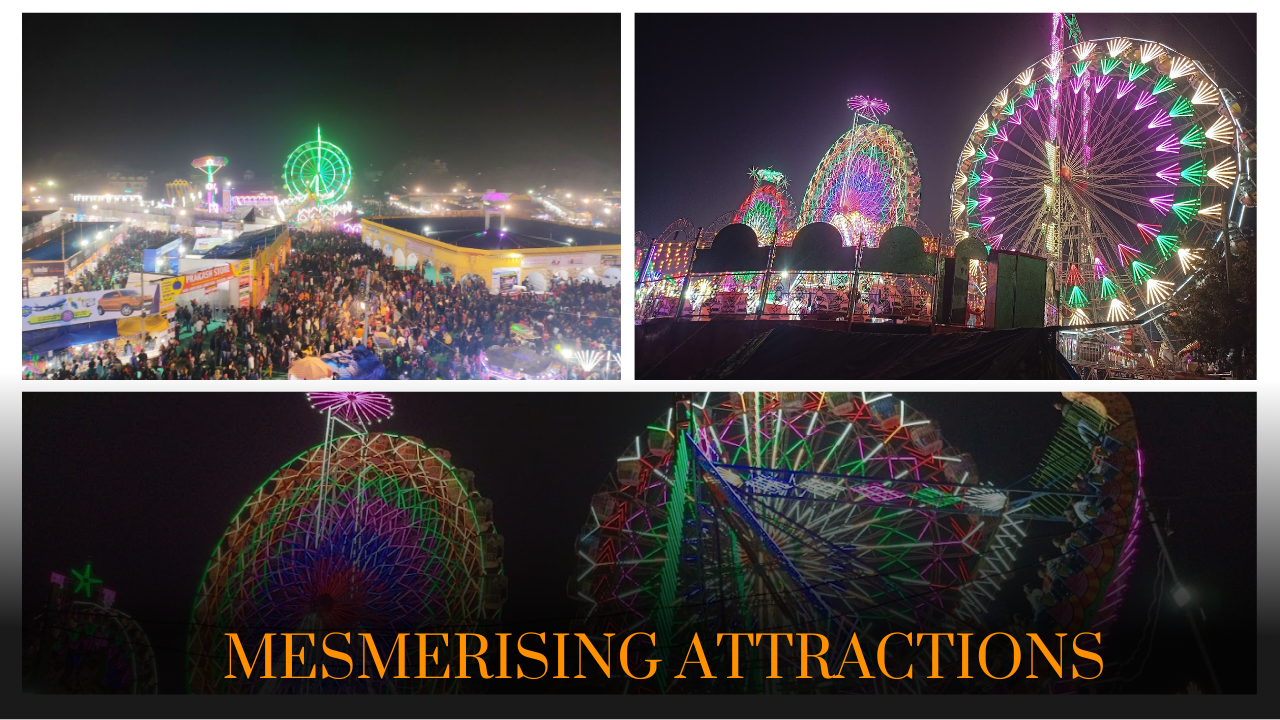
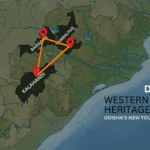

What a great guide! I’ll definitely be recommending this to others.